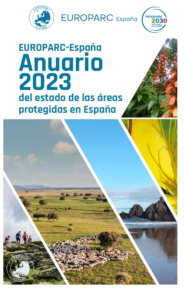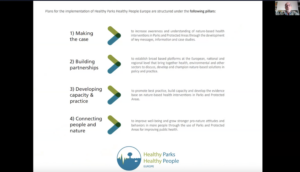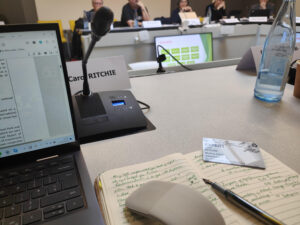Management effectiveness evaluation shows: Finnish park management is of high standard but challenges lie ahead
Photo description: Evaluation Team visiting fortress island Vallisaari. Long closed for military use, the site has remained one of the most diverse nature destinations in the archipelago of capital city Helsinki. From the left: Ben Ross, Nigel Dudley, Sue Stolton (team leader), Michael Hošek, Kari Lahti, Petri Ahlroth, Yu-Fai Leung. Team members absent: Ari-Pekka Auvinen and Naira Dehmel.
Photo: Mervi Heinonen, Metsähallitus Parks & Wildlife Finland
Expert article from Matti Tapaninen, Senior Specialist, Tourism. Metsähallitus Parks & Wildlife Finland.
Conservation agencies around the world need plenty of timely, transparent and quality information to be able to manage their national parks and nature reserves efficiently. In addition to the baseline information of ecological, cultural, social and economic values of Protected Areas, there is growing interest to monitor trends and predict changes in the future. Needs to measure and enhance management effectiveness are also recognized in the Kunming-Montreal Global Biodiversity Framework, which states:
Ensure and enable that by 2030 at least 30 per cent of terrestrial and inland water areas, and of marine and coastal areas, especially areas of particular importance for biodiversity and ecosystem functions and services, are effectively conserved and managed.
EU and national biodiversity strategies play a crucial role in achieving this goal.
Protected Area Management Effectiveness
Protected area management effectiveness (PAME) assessment is a useful tool to organize great amounts of information and it helps to get fresh insights from external evaluators. In 2004, Finland was the first country in the world to commission an independent review of the management effectiveness of the whole protected area system. In 2023, Metsähallitus Parks & Wildlife Finland (PWF) repeated the process. The Evaluation Team itself consisted of experts representing a range of expertise, including managing a park agency, biodiversity research units, conservation-related private consultancies, and visitor and tourism management.
The 2023 PAME Assessment
The 2023 PAME assessment was guided by the Principles of Protected Area Management in Finland, which encompass key components of management objectives, ecosystem services and ecosystem approach, and adaptive management process that are operating under a changing environment along with national and regional obligations. The evaluation protocol entailed a system-wide questionnaire with six broad categories of questions, including context, planning, input/resources, process, outputs, and outcomes.
Special attention was paid to important changes in the management context since 2004, as well as future domestic and regional trends that may facilitate, hinder or otherwise impact management effectiveness in one or more categories. The focus of evaluation was on the protected area system in Finland, but additional evidence was obtained from site assessments using the Management Effectiveness Tracking Tool (METT) in five Protected Areas.
According to the PAME assessment report management of Protected Areas in Finland is of a high standard and the protected area system managed by Parks & Wildlife Finland works well. However, significant challenges lie ahead. Many species are endangered, threats due to climate change are increasing and resources available for management are declining. Henrik Jansson, Executive Director of Parks & Wildlife Finland, says:
The international assessment is an important step towards safeguarding biodiversity and more effective conservation work. This assessment provides guidelines for increasing the impact of the work and helps to compare our competence internationally. Next, we will analyse the recommendations and draw up a development plan from them. We will prioritise the recommendations that we can implement promptly.
A comment by Michael Hošek, President of EUROPARC Federation and member of the international evaluation team
Globally, Finland was the first country to develop a methodology to evaluate the effectiveness of its Protected Areas system in 2004. Moreover, Finnish colleagues understood the importance of an independent perspective, i.e. they invited international experts to the evaluation team.
In 2023, after 20 years, the evaluation was carried out again. The methodology was updated, of course, but with the awareness that the results could be compared to see trends in development.
Personally, I consider the combination of the assessment at the level of the Protected Areas network and the specific sites of great importance. We cannot assume that we have the capacity to carry out a very thorough and repeated evaluation of effectiveness at the level of each individual site. The Finnish example is innovative in this respect, as it combines the assessment at the level of the network and a sample of sites while maintaining the quality of the result. And to make the evaluation truly independent, it is really important to invite colleagues from other countries to the team, taking into account the experience of other countries within Europe and the world. And I hope we have done that. I am personally very happy with the result.
More information
Full evaluation reportThe full evaluation report Management Effectiveness Evaluation of Finland’s Protected Areas 2023 (pdf)
Report summary and recommendationsThe report summary and its recommendations (pdf): Management Effectiveness Evaluation of Finland’s Protected Areas 2023 – Summary of the Evaluation Report and Recommendations.
System level evaluationSystem-level evaluation of protected area management effectiveness for Parks & Wildlife Finland (PAME) – complete assessment questionnaire with evaluation criteria (pdf)
Evaluating Effectiveness (IUCN)Evaluating Effectiveness: A framework for assessing management effectiveness of protected areas. 2nd Edition. (IUCN publication, pdf)
State of play of Protected Areas in Spain
The commitment to Protected Areas in Spain is strong, with more than 36% of the land surface area protected and, shortly, 21% of the marine surface area.
Yearbook 2023 on the state of Protected Areas in Spain
The Yearbook of Protected Areas in Spain 2023, – published by EUROPARC Spain on the 18th of March 2024 and available in Spanish language – showcases the state of the art of Protected Areas in this country and includes an analysis of several aspects of concern.
Spain has 36.7% of the protected land area and 12.3% of the marine area, a figure that will soon rise to 21%. It stands out as the country with higher contribution of Protected Areas to the European Natura 2000 network, and the one with the highest number of biosphere reserves in the world, with 53 designated territories. These figures provide a solid basis for tackling many of the commitments related to the European Union’s Biodiversity Strategy.
Partnerships for conservation and socio-economic revitalisation
Protected Areas are essential tools within environmental, social and economic policies. Furthermore, in an increasingly urbanised society, they provide access to nature and to its enjoyment – Spanish National Parks alone receive almost 14 million visitors.
Protected Areas are also areas of opportunity for green activity and employment, especially in rural areas.
says Juana Barber, President of EUROPARC Spain.
Additionally, initiatives such as the European Charter for Sustainable Tourism in Protected Areas (ECST) – promoted by the EUROPARC Federation – are an example scheme that allows quality recognition for products and services from Protected Areas. The ECST has involved 30 protected natural areas in Spain, 526 tourism companies and 10 travel agencies that voluntarily participate in the initiative.
Active management, experiences and field practices
Protected Areas play an essential role not solely in the conservation and restoration of ecosystems and their biodiversity. There is growing evidence and experiences of the role that Protected Areas play in tackling the challenges of climate change, articulating the necessary cooperation between sectoral policies and stressing the socio-economic benefits of nature conservation.

Among other experiences, the Yearbook of Protected Areas in Spain 2023 portrays examples on the contribution of Protected Areas to the different future challenges we, as a society, face. Such is the case of an European project for adaptation to climate change in a Natural Park in Galicia and an initiative for climate change mitigation in the Natural Parks of the Chartered Community of Valencia. Likewise, we can find examples like the commitment to conservation and revitalisation of rural areas in a recently created Natural Park in La Rioja and the experience of a decade of collaborative work to promote sustainable tourism in La Gomera island, driven by Garajonay National Park.
The report is available online at EUROPARC Spain website in Spanish language – take a closer look to this significant report by clicking the button below.
To the Yearbook 2023 pageTraining in co-management of Protected Areas in Portugal: planning for HPHPe
Group photo of Portuguese PA representatives in February
30 Park Managers engaged in a training session to include Healthy Parks Healthy People in their Action Plans.
HPHPe training event in Portugal
On the 21st of March, 30 Portuguese Park Managers engaged in a training course for technicians in Co-management of Protected Areas in Portugal – Introducing the HPHP Europe in the PA Action Plan.
The attending park technicians were from both Municipalities and the ICNF (Portuguese Agency for Nature Conservation and Forests) and are actively involved in promoting and communicating the value of Protected Areas.
Led by Carles Castell, a member of the EUROPARC HPHPe Commission, this introduction provided valuable insights and showcased successful examples from across Europe. The aim was to inspire and empower participants to play an active role in developing initiatives aligned with the HPHPe methods and principles.

The session is included in a long-term capacity-building programme, designed to build the skills of the Protected Areas technicians.
This marks a significant milestone as Portugal embraces the Healthy Parks Healthy People Europe initiative for the first time.
By fostering a deeper connection between people and parks, with an emphasis on restoration and health, we strive to create happier and healthier communities.
This event serves as the initial step towards implementing initiatives that promote well-being within Portuguese parks, setting the stage for a brighter, healthier future.
Healthy Parks Healthy People Europe Programme is a long-standing initiative of EUROPARC Federation.
The HPHPe toolkit “Health and Well-Being Benefits from Parks and Protected Areas” provides practical advice to set up policy and activities in your Park; brings you the latest evidence, reports and other useful resources; and shares inspiring examples from across the EUROPARC network. A must-read for all Protected area staff (including planners, site managers, rangers, and wardens) but also to governmental bodies aiming to develop national and regional policy to leverage health benefits from natural areas.
If you wish to get inspiration to how get active you can take a look at our:
If you are already active and wish to share your experience with the network you are welcome to submit a case study
Group of Specialists on European Diploma for Protected Areas annual meeting
What is the European Diploma for Protected Areas
The European Diploma for Protected Areas is a prestigious international award granted since 1965 by the Committee of Ministers (Foreign Ministers of each Member State) of the Council of Europe. It recognises natural and semi-natural areas and landscapes of exceptional European importance for the preservation of biological, geological and landscape diversity, which are managed in an exemplary way.
About the meetings and the role of EUROPARC Federation
The Group of Specialists on the European Diploma for Protected Areas annual meeting took place from 20 to 21 February 2024 in Strasbourg and was attended by EUROPARC Federation’s Executive Director.
Our Executive Director Carol Ritchie is a member of the Group of Specialists on the European Diploma for Protected Areas, the body that advises the Committee of Ministers, whether an area in question is of exceptional European interest.
At the meeting, the Group discussed the consequences of the cessation of the membership of the Russian Federation to the Council of Europe and of the freeze of the technical cooperation with Belarus.
There was also the opportunity to reflect how the monitoring of the European Diploma can contribute to the achievement of the Strategic Plan of the Bern Convention and to examine the findings of on-the-spot appraisal visits to seven Protected Areas. Lastly, discussion revolved on the several sites requiring particular attention, and planning the celebration of the 60th anniversary of the European Diploma in 2025.
It was great to see EUROPARC members both in the Group of Specialists and amongst the 66 Diploma sites across Europe (after the exclusion of Russian and Belarusian sites) .
It was especially heartening to see and hear the presentation from Sierra Nevada National Park, Spain, as it made its new application for the Diploma. It is an award that not only looks at the assets of a site but at how they are managed and has high political significance and visibility.
Looking forward to the 60th anniversary
EUROPARC would encourage members across Europe to consider making such an application, especially as the Diploma reaches its 60th anniversary next year. It would be an ideal time to shine a spotlight on the great work being done by Protected Areas to protect our nature in all it is glorious diversity.
